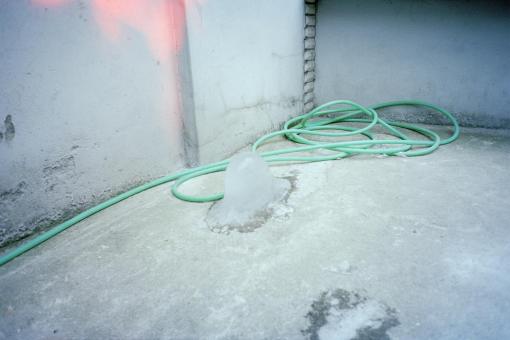Entrevista a Dayoung Kang
강다영 Dayoung Kang nace en 1984 en Hong-Sung, Corea del Sur. Es licenciada en fotografía por la Universidad de Chung-ang. Ha participado en diversas exposiciones en Europa (Finlandia, Alemania, Eslovaquia) y en Corea del Sur.
De la serie Condensed Memory
¿Puedes contarnos brevemente cómo fueron tus inicios en la fotografía?
Voy a saltarme esta pregunta. No me viene nada a la mente.
(Dos semanas más tarde)
Vale, he estado pensando sobre mi pasado durante las últimas dos semanas. Todavía no estoy muy segura, pero ahora mismo tengo un amante. Existe la posibilidad de que empezara a hacer fotografías para conocer a esta persona. Es algo tan romántico. En realidad siempre he sido una romántica.
En tu serie Swallow reflexionas sobre la identidad y el anonimato. ¿Por qué no muestras los rostros de la gente en tus fotografías?
Creo que hay muchas maneras de definir el modo en el que fotografié Swallow. Simplemente lo hice porque quería. Fotográficamente, prefiero la tranquilidad, y mostrar los rostros en las fotografías puede resultar un poco chillón. El hecho de cubrir los rostros me tranquilizaba y me permitía contar más historias. Soy una de esas personas que encuentran la posibilidad de contar historias a partir de lo invisible.
De la serie Swallow
Las fotografías de Swallow parecen haber sido impresas sobre tela o hechas con un transfer de Polaroid. El resultado me parece interesante. ¿Podrías explicarnos cómo has logrado ese efecto en el post-procesado?
Me temo que he tenido intentos fallidos para poder hacer un transfer de la emulsión a Polaroid o tela. Las fotografías las retoqué digitalmente después de escanear papel tradicional coreano. Me atraían la textura y la tonalidad de este papel. Se podría conseguir un efecto parecido escaneando cualquier otro tipo de papel de textura similar o antiguo.
En tu obra Condensed memory, hay algo enigmático, algo de imprevisible dentro de lo cotidiano. ¿Qué es lo que te inspiró a la hora de fotografiar estas imágenes?
Me estoy centrando en el concepto de límite, concibiéndolo como algo ambiguo e inquieto. En ocasiones siento una presión procedente de un tipo de relación o inquietud que no podría definir correctamente. En realidad, creo que lo más adecuado sería esconderme o huir, pero todo el mundo guarda cosas de las que no quiere hablar, o tiene recuerdos en los que intenta no pensar. Eso mismo me pasa a mí. Trabajo con el concepto de “inquietud”. Por más que el tiempo pase, mis recuerdos afloran y provocan esa inquietud.
Mi acto fotográfico comenzó a raíz de esos recuerdos. El mundo que veo ante mis ojos no es ningún espejo de la realidad, sino un espejo de la inquietud que tengo dentro de mí. Y lo que quiero hacer es reflejar todo ese espejo mediante fotografías. Probablemente mis pensamientos sean imposibles de comunicar porque se tratan de algo íntimo pero, aún así, trabajo en la prolongación de mis recuerdos pasados y espero hallar la respuesta a esa inquietud.
Díptico de la serie Condensed Memory
Durante 2009 y 2011 participaste en varias muestras en países europeos. ¿Cómo fue la experiencia?
Gracias al profesor alemán Walter Bergmoser, tuve la oportunidad de exponer en Europa con mis colegas Coreanos, algo que supuso una experiencia increíble. Me pareció que las galerías europeas eran mucho más abiertas hacia los visitantes. No estaba familiarizada con eso de contestar preguntas de personas con edades y culturas diferentes a la mía, pero fue muy estimulante.
¿Tienes algún fotógrafo de referencia?
Mis referentes en fotografía son todas aquellas personas que he conocido hasta ahora. En realidad, hasta hace poco, mi mayor referente ha sido este conjunto de piedras apiladas en un charco (ver foto más abajo).
De la serie Condensed Memory
¿Qué opinas de la fotografía asiática actual?
Creo que la fotografía asiática es muy progresista, singular y original. Apenas acabo de empezar en esto —llevo menos de 10 años fotografiando— así que no me resulta fácil seguir el flujo de la fotografía asiática, pero muchos artistas asiáticos son unos adelantados a nivel global y están en el punto de mira. Esto demuestra la singularidad de la fotografía asiática actual.
¿Estás trabajando en algún proyecto actualmente? Si es así, ¿podrías adelantarnos algo?
Ahora mismo estoy trabajando en dos proyectos: Acne (a bud) y Travel alcohol (a way to travel).
Me salió acné en el momento en el que empecé a amar. Algo brotó dentro de mi junto con el acné. Me encanta el hecho de que algo salga a borbotones con ansia incontrolable. A través de este trabajo, quiero contener algo que brota, tenga la forma que tenga.
Travel alcohol (a way to travel) es la historia de alguien —tú y yo— al que le gusta viajar y beber. Tengo pensado publicar una pequeña cantidad de fotografías tomadas mientras viajaba con bebidas.
De la serie A bud








